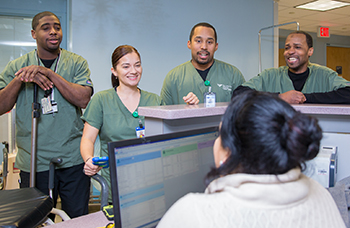
Talking with Patient Transport Supervisor Yolanda Sydnor in the Saint Raphael Campus Radiology holding area are transporters (l-r): Percel Boyd, Rosalina Rivera, Lamar Shell and Jermaine Lewis.
Asked what he finds most challenging about his job, James Wilkerson replies with a chuckle, "My sore feet!"
No wonder. During a typical shift, he and fellow patient transport associates at the York Street Campus will walk about 17,000 steps – over eight miles. Their counterparts at the Saint Raphael Campus average 14,000 steps – about 6.6 miles.
Whether they're taking patients for a test or treatment, to a unit at admission or the lobby for discharge, patient transporters are vital members of the care team. During the fiscal year that ended Sept. 30, 2015, 162 transporters completed nearly 500,000 transports on both campuses – a record high.
Transporters help ensure patients get where they need to be as efficiently and safely as possible, 24/7. Each transport is timed, and staff are expected to complete at least two an hour. That can be challenging, since jobs are prioritized based on patients' medical needs vs. their locations in the hospital.
"Patients sometimes ask, ‘Do you ever get lost?'" said Lamar Shell, an SRC transporter.
Coordinating transports throughout both hospital campuses is a challenging job performed by a lead transport associate – informally called the "traffic controller." Because a transporter might be needed to move a patient at any time, one or more must always be available. That's why Patient Transport uses a staggered schedule, with groups of staff members coming in every hour, vs. working traditional day, evening and night shifts.
The traffic controller's job has become a little easier since the department went live on Epic and transporters began using iPod Touches that allow them to easily indicate their availability and view and accept assignments.
While they work efficiently, transporters never forget that many of the people they're pushing in wheelchairs or on stretchers are physically and emotionally fragile.
"The transporters are often patients' first and last impressions of the hospital," said Tina Bennett, Patient Transport director. "They have to find that balance between efficiency and wowing the patient."
"When patients come in sick and tired, we are part of the team that makes them feel more comfortable," added Larry Cooper, YSC.
Transporters use different techniques to put patients at ease. Wilkerson likes to make patients laugh. Novelette Forte said just listening patients' concerns can help. Rosalina Rivera has learned to quickly assess patients' moods, and determine if they want to chat or prefer some peace and quiet. Jermaine Lewis has learned it's often the simple things that make a difference.
"You can really make a patient's day with a warm blanket," he said.